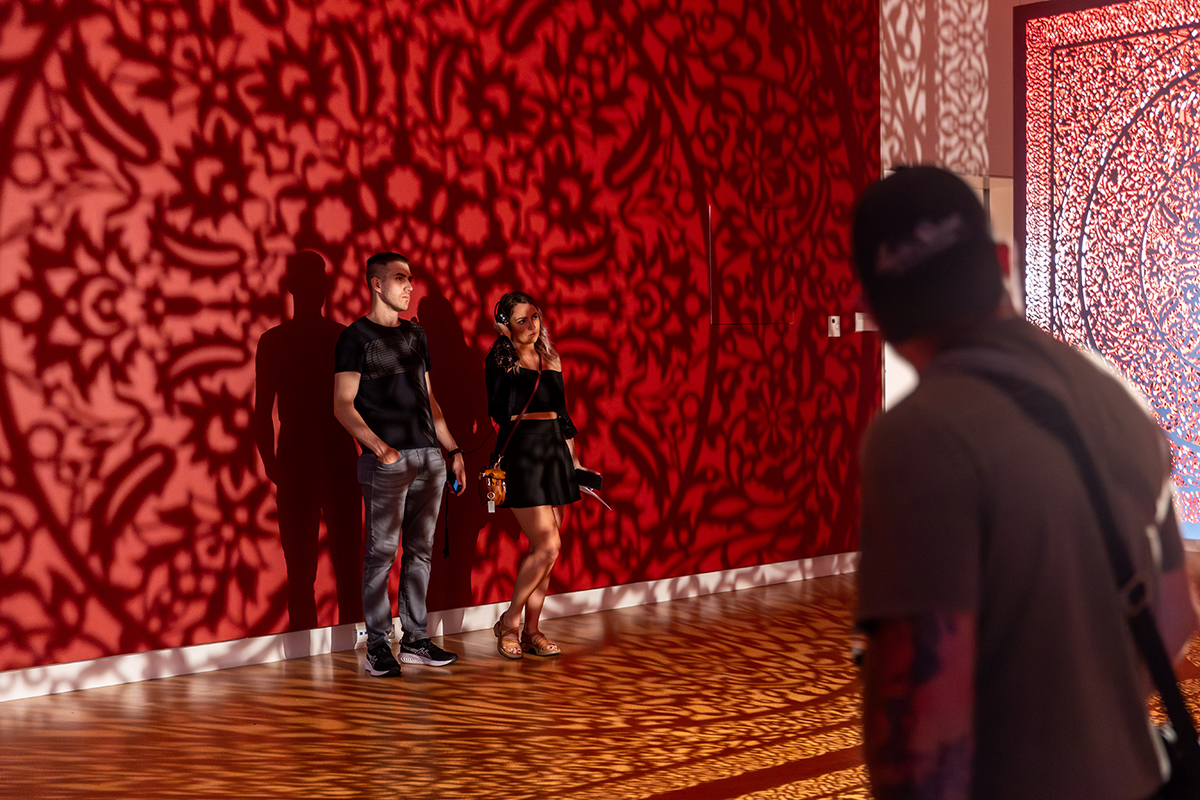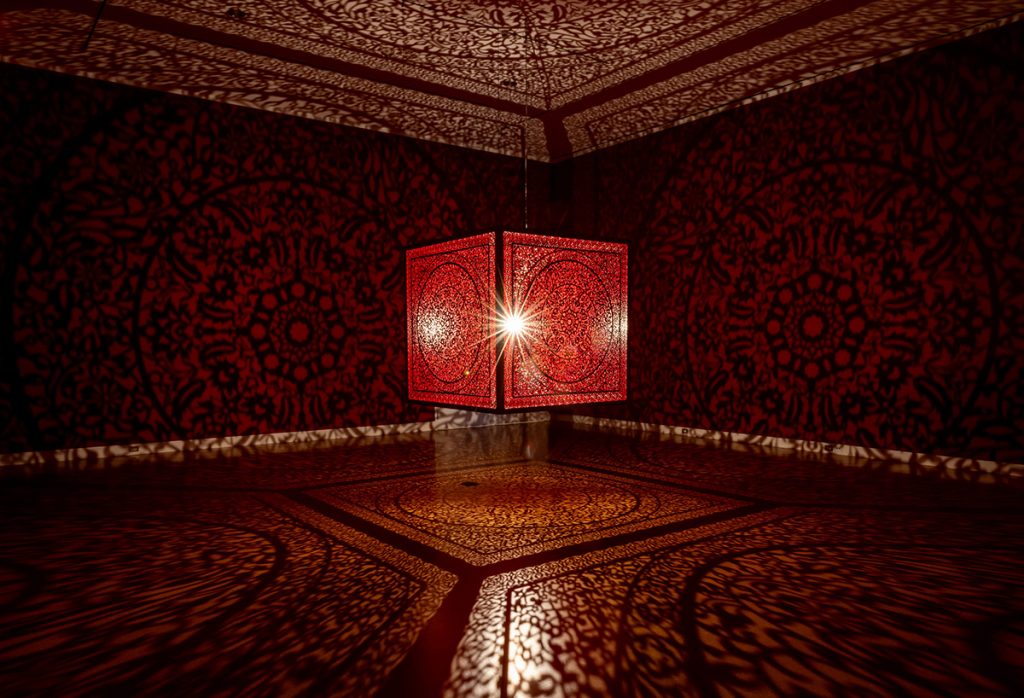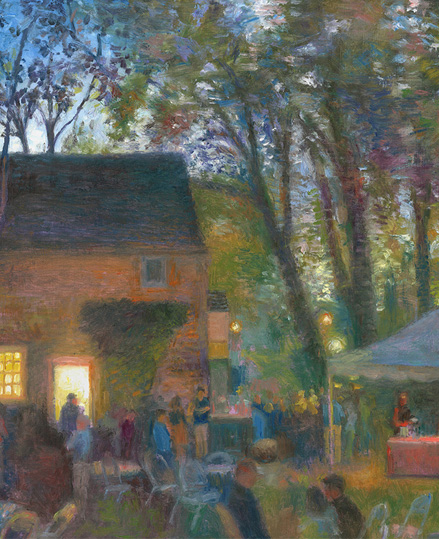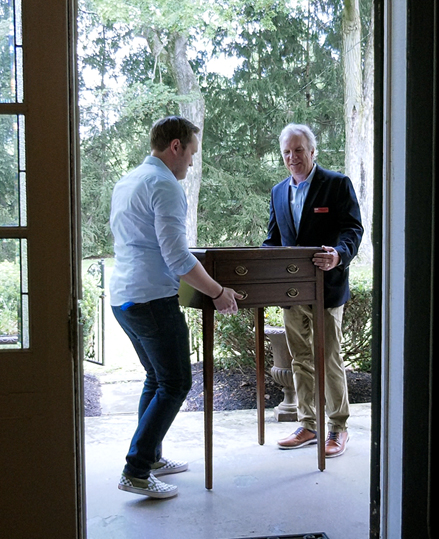Michener Art Museum visitors are part of the art with new exhibition, Anila Quayyum Agha: Interwoven, a retrospective on the acclaimed Pakistani American visual artist
Reported on Thursday, August 14, 2025.

Pictured Above: Anila Quayyum Agha, All the Flowers Are For Me, 2016. Lasercut lacquered steel and halogen bulb, 60 x 60 x 60 inches. Cincinnati Art Museum. Alice Bimel Endowment for Asian Art. Photo courtesy of The Westmoreland Museum of American Art.. Photo Credit: Contributed.
NEWSROOM POST: DOYLESTOWN, PENNSYLVANIA
The immersive exhibition features the room-size light box installation All the Flowers are for Me, in context with nearly 40 artworks that explore cultural identity, the role of women, and the immigrant experience
Doylestown, PA —Anila Quayyum Agha: Interwoven, on view September 6, 2025– January 11, 2026 at Michener Art Museum, features immersive art installations from this important Pakistani American artist, who challenges the boundaries between art and craft with traditional techniques.
The exhibition compels awe and wonder with an Anila Quayyum Agha light box experience, grounding it in context with 38 artworks in the most comprehensive presentation of her career to date. The retrospective is on national tour with a four-month East Coast appearance in Bucks County, Pa.
Through blending modern materials and methods with textile processes, like embroidery and beading, the artist evokes cultural identity, the role of women in society, and the immigrant experience. Born in Lahore, Pakistan, in 1965, Agha immigrated to the United States in 1999, making work for the last 25 years that draws from her Eastern background and her Western life, to increasing critical and popular acclaim.
Interwoven provides visitors a profound orientation to Agha’s extensive work across media, by including sculpture, paintings, and works on paper from the artist’s own studio and significant loans from public and private collections. The exhibition surveys work from every period of her career, with visual references to wide-ranging sources and historical moments, from the Alhambra palace in Granada, Spain, to medieval Venice, to the American Light and Space movement of the 1960s.
“I do not have a single story,” Agha said. “I have multiple stories that become interwoven to create a tapestry that is colorful, that is varied, that has pattern, that has beauty and light. We have to explore the multiple stories that make our lives.”
The iconic All the Flowers are for Me, a light box installation where patterns from medieval Persian textiles extend across every surface in the gallery, illustrates how Agha thinks of light as a medium in itself. Light and shadow are as central to Agha’s artist vocabulary as thread, wax, paper, and steel. The influence of textiles on Agha’s work is also evident in the awe-inspiring A Flood of Tears, where hundreds of 10-inch upholstery needles are suspended with glistening glass-beaded strands. Agha utilizes textiles and associated craft techniques, often attributed to women and, often, undervalued, to elevate traditional domestic work in art.
“Agha’s masterful use of beauty, light, and shadow has a profound, almost arresting effect,” said Laura Igoe, Gerry and Marguerite Lenfest Chief Curator. “Her installations don’t just captivate the eye—they create a contemplative space that invites visitors to engage with questions of identity, craft, and belonging. You become part of the work, not only as you move through it, but also in the moments of reflection it provokes.”

Pictured Above: Anila Quayyum Agha, All the Flowers Are For Me, 2016. Lasercut lacquered steel and halogen bulb, 60 x 60 x 60 inches. Cincinnati Art Museum. Alice Bimel Endowment for Asian Art. Photo courtesy of The Westmoreland Museum of American Art.. Photo Credit: Contributed.
Related programming at the Michener during Anila Quayyum Agha: Interwoven is designed for deeper engagement with the rich themes of the exhibition. Regular mindfulness and yoga sessions in the gallery spaces will be held through January, along with textile-based workshops and gallery tours. The Putman Arts Leader Lecture Series on Thursday, October 16 will host Agha as the guest speaker for “Interwoven Legacies: Women, Spirituality, and the Art of Anila Agha.”
“Michener Art Museum is honored to introduce visitors to the artwork of Anila Quayyum Agha, and to the artist herself,” said Executive Director Anne Corso. “Interwoven perfectly aligns with the Museum’s dedication to showcasing American Art and celebrating contemporary craft, but with a uniquely global perspective.”
Anila Quayyum Agha: Interwoven is organized by The Westmoreland Museum of American Art. The exhibition is curated by Jeremiah William McCarthy. Presentation of the exhibition at the Michener Art Museum is coordinated by Gerry and Marguerite Lenfest Chief Curator Laura Turner Igoe and Director of Exhibitions Joshua Lessard.
Anila Quayyum Agha: Interwoven is made possible by generous support from the Henry Luce Foundation, the Terra Foundation for American Art, the Hillman Foundation, the Heinz Endowments, the National Endowment for the Arts, and The Fine Foundation.
Major support for Anila Quayyum Agha: Interwoven at the Michener Art Museum is provided by Richard C. von Hess Foundation, Tim Griffith and Anne Corso, Alex and Pat Gorsky, Jim McKinney, Bucks County Tourism Grant Program, and Coby Foundation, Ltd., with additional support from Bucks County Foundation.
About the Artist:
Anila Quayyum Agha is internationally recognized for her award-winning large-scale installations that use light, shadow, and pattern to create inclusive shared experiences. She holds a BFA from the National College of Art, Lahore, Pakistan, and an MFA from the University of North Texas, Denton. She is a Morris Eminent Scholar of Art, Augusta University, and was previously Associate Professor in Drawing at the Herron School of Art and Design, Indiana University–Purdue University Indianapolis. Major awards include the Joan Mitchell Foundation Painters & Sculptors Grant (2019) and the Smithsonian Artist Research Fellowship (2021).
Agha’s work is in the collections of Amon Carter Museum of American Art, Fort Worth, TX; Chrysler Museum of Art, Norfolk, VA; Cincinnati Art Museum, OH; Columbia Museum of Art, SC; Eskenazi Museum of Art, Bloomington, IN; Grand Rapids Art Museum, MI; Kiran Nader Art Museum, Delhi, India; Kunsthaus Zurich, Zurich, Switzerland; Peabody Essex Museum, Salem, MA; University of New Mexico Art Museum, Albuquerque, NM; The Westmoreland Museum of American Art, Greensburg, PA; among many others. Her 2013 installation, Intersections, was the first time in ArtPrize history that winner of the Grand Rapids, MI., competition was awarded both the Public Vote Grand Prize and split the Juried Grand Prize. For the 2019 Venice Biennial, Agha was included in a collateral event, She Persists, with 22 contemporary feminist artists. Agha received an NEA grant to support a 2024 traveling retrospective at the Westmoreland Museum of American Art in Greensburg, PA. She is represented by Sundaram Tagore Gallery, NY.
About Michener Art Museum:
Website: michenerartmuseum.org
Address: 138 S. Pine Street, Doylestown PA 18901
Hours: Wednesdays–Sundays, 10 a.m.–5 p.m. Admission is free on the second Sunday of the month with support from Art Bridges Foundation.
Michener Art Museum in Doylestown is dedicated to preserving, interpreting, and exhibiting the art and cultural heritage of the Bucks County region. Home to the largest public collection of Pennsylvania Impressionist paintings and known for studio craft, the Michener is named for Doylestown’s most famous son James A. Michener, a Pulitzer Prize-winning writer who first dreamed of a regional art museum in the early 1960s. The Museum was originally home to the 19th-century Bucks County Prison and is surrounded by the historic stone prison walls which are part of the Patricia D. Pfundt Sculpture Garden, terraces, and a landscaped courtyard. Michener Art Museum features nationally touring special exhibitions, work from regional artists in distinctive galleries, and the quiet and serene Nakashima Reading Room.

 Independent Arts News Reporting
Independent Arts News Reporting 
